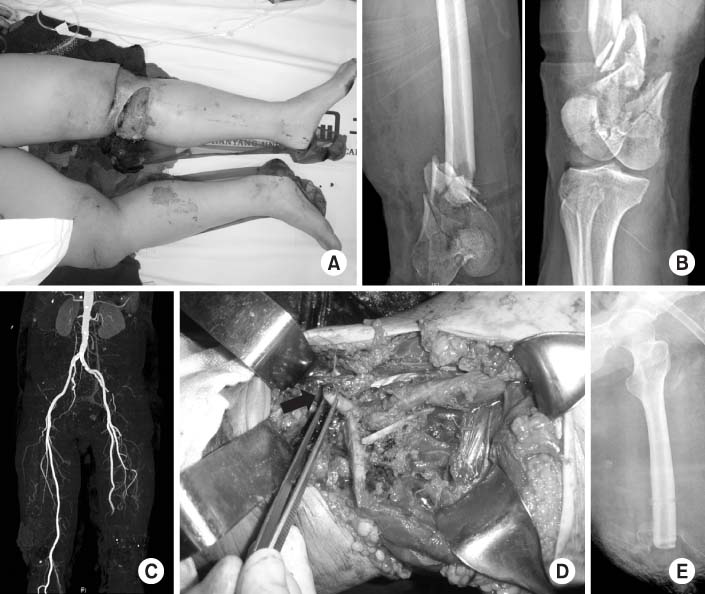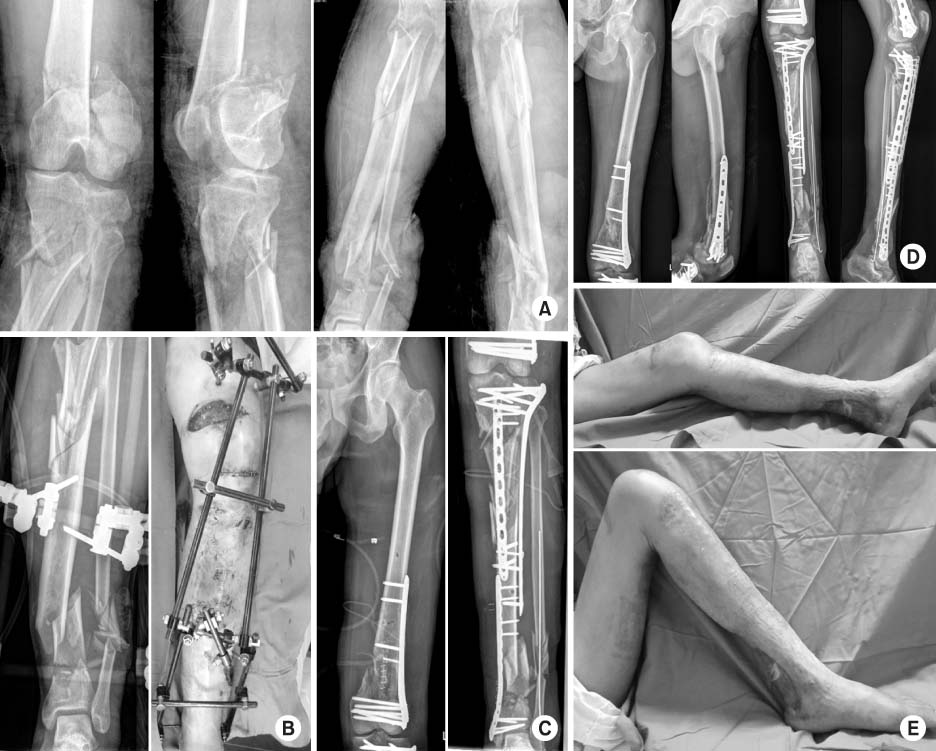J Korean Fract Soc.
2015 Jul;28(3):198-204. 10.12671/jkfs.2015.28.3.198.
Mangled Extremity: Salvage versus Amputation
- Affiliations
-
- 1Department of Orthopaedic Surgery, Guri Hospital, Hanyang University College of Medicine, Guri, Korea. kcpark@hanyang.ac.kr
- KMID: 2184420
- DOI: http://doi.org/10.12671/jkfs.2015.28.3.198
Abstract
- No abstract available.
MeSH Terms
Figure
Reference
-
1. Gregory RT, Gould RJ, Peclet M, et al. The mangled extremity syndrome (M.E.S.): a severity grading system for multisystem injury of the extremity. J Trauma. 1985; 25:1147–1150.2. Kuz JE. The ABJS presidential lecture, June 2004: our orthopaedic heritage: the American Civil War. Clin Orthop Relat Res. 2004; (429):306–315.3. Bondurant FJ, Cotler HB, Buckle R, Miller-Crotchett P, Browner BD. The medical and economic impact of severely injured lower extremities. J Trauma. 1988; 28:1270–1273.
Article4. Georgiadis GM, Behrens FF, Joyce MJ, Earle AS, Simmons AL. Open tibial fractures with severe soft-tissue loss. Limb salvage compared with below-the-knee amputation. J Bone Joint Surg Am. 1993; 75:1431–1441.
Article5. Francel TJ, Vander Kolk CA, Hoopes JE, Manson PN, Yaremchuk MJ. Microvascular soft-tissue transplantation for reconstruction of acute open tibial fractures: timing of coverage and long-term functional results. Plast Reconstr Surg. 1992; 89:478–487.
Article6. Dagum AB, Best AK, Schemitsch EH, Mahoney JL, Mahomed MN, Blight KR. Salvage after severe lower-extremity trauma: are the outcomes worth the means? Plast Reconstr Surg. 1999; 103:1212–1220.
Article7. Hertel R, Strebel N, Ganz R. Amputation versus reconstruction in traumatic defects of the leg: outcome and costs. J Orthop Trauma. 1996; 10:223–229.
Article8. Bosse MJ, MacKenzie EJ, Kellam JF, et al. An analysis of outcomes of reconstruction or amputation after leg-threatening injuries. N Engl J Med. 2002; 347:1924–1931.
Article9. MacKenzie EJ, Bosse MJ, Pollak AN, et al. Long-term persistence of disability following severe lower-limb trauma. Results of a seven-year follow-up. J Bone Joint Surg Am. 2005; 87:1801–1809.
Article10. Lange RH, Bach AW, Hansen ST Jr, Johansen KH. Open tibial fractures with associated vascular injuries: prognosis for limb salvage. J Trauma. 1985; 25:203–208.11. Howe HR Jr, Poole GV Jr, Hansen KJ, et al. Salvage of lower extremities following combined orthopedic and vascular trauma. A predictive salvage index. Am Surg. 1987; 53:205–208.12. Johansen K, Daines M, Howey T, Helfet D, Hansen ST Jr. Objective criteria accurately predict amputation following lower extremity trauma. J Trauma. 1990; 30:568–572.
Article13. Russell WL, Sailors DM, Whittle TB, Fisher DF Jr, Burns RP. Limb salvage versus traumatic amputatio. A decision based on a seven-part predictive index. Ann Surg. 1991; 213:473–480.14. McNamara MG, Heckman JD, Corley FG. Severe open fractures of the lower extremity: a retrospective evaluation of the Mangled Extremity Severity Score (MESS). J Orthop Trauma. 1994; 8:81–87.15. Bonanni F, Rhodes M, Lucke JF. The futility of predictive scoring of mangled lower extremities. J Trauma. 1993; 34:99–104.
Article16. Bosse MJ, MacKenzie EJ, Kellam JF, et al. A prospective evaluation of the clinical utility of the lower- extremity injury-severity scores. J Bone Joint Surg Am. 2001; 83-A:3–14.17. Suedkamp NP, Barbey N, Veuskens A, et al. The incidence of osteitis in open fractures: an analysis of 948 open fractures (a review of the Hannover experience). J Orthop Trauma. 1993; 7:473–482.
Article18. MacKenzie EJ, Jones AS, Bosse MJ, et al. Health-care costs associated with amputation or reconstruction of a limb-threatening injury. J Bone Joint Surg Am. 2007; 89:1685–1692.
Article19. Bosse MJ, McCarthy ML, Jones AL, et al. Lower Extremity Assessment Project (LEAP) Study Group. The insensate foot following severe lower extremity trauma: an indication for amputation? J Bone Joint Surg Am. 2005; 87:2601–2608.20. MacKenzie EJ, Bosse MJ, Castillo RC, et al. Functional outcomes following trauma-related lower-extremity amputation. J Bone Joint Surg Am. 2004; 86-A:1636–1645.
Article
- Full Text Links
- Actions
-
Cited
- CITED
-
- Close
- Share
- Similar articles
-
- Limb Salvage versus Early Amputation according to Mangled Extremity Severity Score in Treatment of the Lower Extremity Open Fractures associated with Severe Soft Tissue Injury
- Comparison of Quality of Life among Patients with Mangled Trauma
- Vascular Injury of Lower Extremity
- Uncommon Mechanism of Mangled Extremity; Three Cases of Rope Entanglement Injury of the Lower Leg
- Risk Factors of Amputation in Lower Extremity Trauma with Combined Femoropopliteal Arterial Injury



